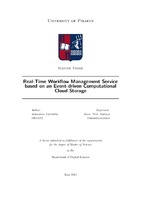Real-time workflow management service based on an event-driven computational cloud storage

Προβολή/
Θεματική επικεφαλίδα
Cloud computing ; WorkflowΛέξεις κλειδιά
Cloud computational storageΠερίληψη
Applications built in a strongly decoupled, event-based interaction style have
many commendable characteristics, including ease of dynamic configuration, accommodation
of platform heterogeneity, and ease of distribution over a network. It is
not always easy, however, to humanly grasp the dynamic behavior of such applications,
since many threads are active and events are asynchronously transmitted. With
the growing complexity of industrial use case requirements, independent and isolated
triggers cannot fulfil the demands anymore. Fortunately, an independent trigger can
be triggered by the result produced by other triggered actions and enables the modelling
of complex use cases. The chains or graphs that consist of triggers, are called
workflows. Therefore, workflow construction and manipulation become a must for implementing
the complex use cases. This study presents an approach that aids in the
discovery and visualization of the behaviors of event-based applications. It applies to
real, implemented systems, without requiring the presence of component source code,
and supports partial or incomplete, heuristic behavior specifcations. A prototype implementation
of this study approach, was applied to VISION Cloud, a computational
storage system that executes small programs, called storlets, as independent computation
units in the storage. Similar to the trigger mechanism in database systems, storlets
are triggered by specific events and then execute computations. Consequently, one storlet
can also be triggered by the result produced by other storlets, and that is called
connections between storlets. Due to the growing complexity of use case requirements,
an urgent demand is to have real-time storlet work
ow management supported in VISION
system. Furthermore, because of the existence of connections between storlets
in VISION, problems such as, non-termination triggering and unexpected overwriting,
appear as side-effects.
The thesis is part of the European Project VISION Cloud and it was written
in collaboration with Swedish Institute of Compute Science (SICS), a partner of the
project.


